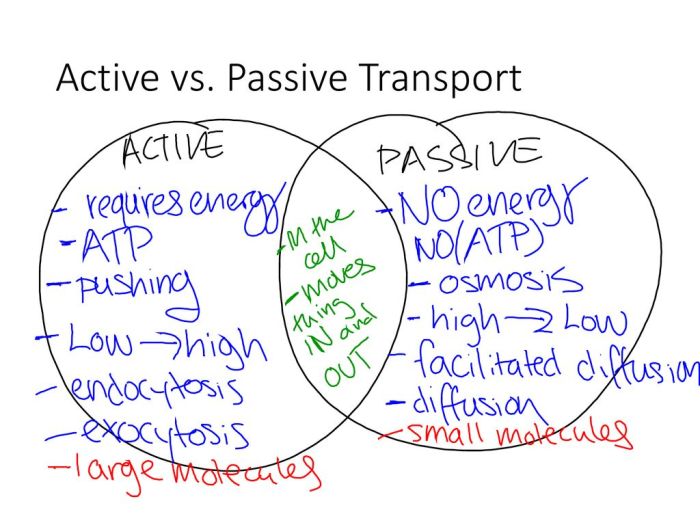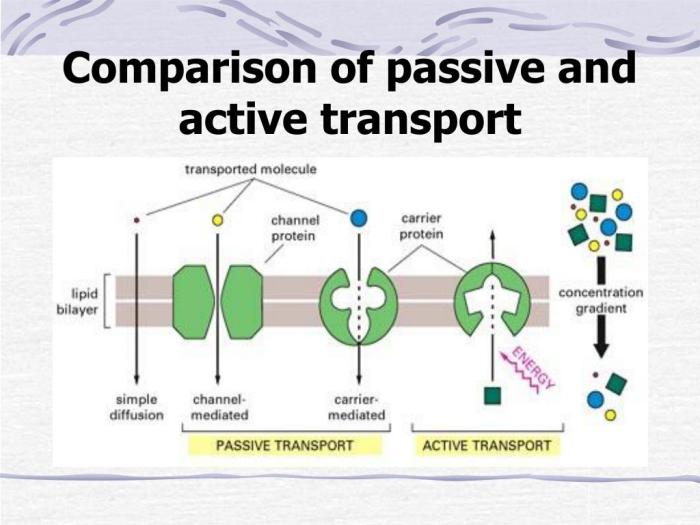The venn diagram of active and passive transport serves as a valuable tool for understanding the fundamental differences between these two critical biological processes. Active transport, characterized by its energy-dependent nature, stands in stark contrast to passive transport, which relies on concentration gradients to facilitate movement.
This comprehensive guide delves into the mechanisms, energy requirements, and direction of movement associated with each type of transport, providing a comprehensive overview of these essential physiological processes.
As we delve deeper into the intricacies of active and passive transport, we will uncover the specific solutes transported by each mechanism and explore the implications of these processes for cellular function. Through a detailed comparison table, we will systematically contrast the key features of these two transport mechanisms, enhancing our understanding of their distinct roles in maintaining cellular homeostasis.
Active and Passive Transport: Venn Diagram Of Active And Passive Transport

Cells require the movement of molecules across their membranes to maintain homeostasis and perform essential functions. This movement can occur through two main mechanisms: active transport and passive transport.
Types of Transport
- Active transport: The movement of molecules against their concentration gradient, requiring energy input.
- Passive transport: The movement of molecules down their concentration gradient, without energy input.
Mechanisms of Transport
Active transport
Active transport utilizes membrane proteins, known as pumps or carriers, that bind to specific molecules and transport them across the membrane. The energy required for this process comes from the hydrolysis of ATP.
Passive transport
Passive transport occurs through channels or pores in the membrane. These channels allow molecules to diffuse down their concentration gradient, moving from areas of high concentration to areas of low concentration.
Energy Requirements
Active transport
Active transport requires energy in the form of ATP hydrolysis to move molecules against their concentration gradient.
Passive transport
Passive transport does not require energy input, as molecules move down their concentration gradient.
Direction of Movement
Active transport
Active transport can move molecules in both directions across the membrane, against or with their concentration gradient.
Passive transport
Passive transport always moves molecules down their concentration gradient, from areas of high concentration to areas of low concentration.
Solutes Transported, Venn diagram of active and passive transport
Active transport
Active transport can transport a wide range of molecules, including ions, nutrients, and small molecules, across the membrane.
Passive transport
Passive transport is typically limited to the movement of small, nonpolar molecules, such as oxygen, carbon dioxide, and water, across the membrane.
Comparison Table
| Type of Transport | Mechanism | Energy Requirements | Direction of Movement | Solutes Transported |
|---|---|---|---|---|
| Active transport | Membrane pumps or carriers | ATP hydrolysis | Against concentration gradient | Ions, nutrients, small molecules |
| Passive transport | Channels or pores | None | Down concentration gradient | Small, nonpolar molecules |
FAQ Explained
What is the key difference between active and passive transport?
Active transport requires energy to move molecules against a concentration gradient, while passive transport does not require energy and relies on concentration gradients to facilitate movement.
What are some examples of active transport?
Examples of active transport include the sodium-potassium pump and the calcium pump.
What are some examples of passive transport?
Examples of passive transport include diffusion and osmosis.

